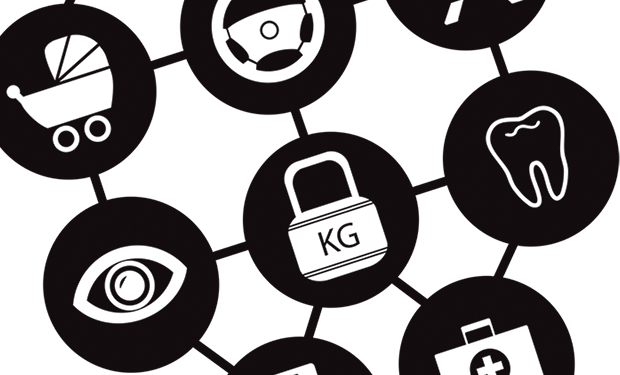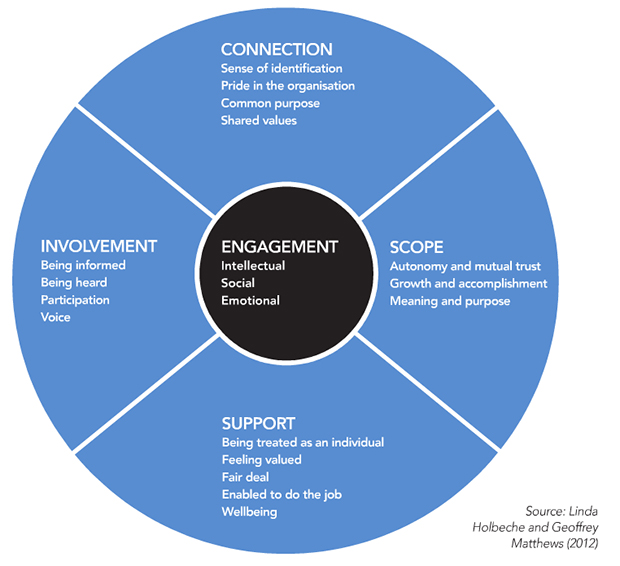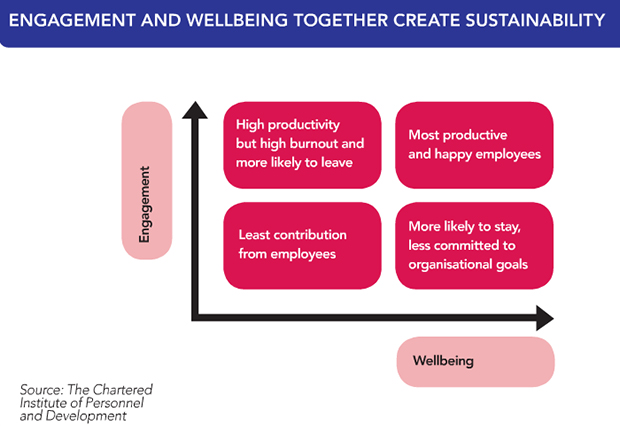Trying to define employee engagement is about as easy for an employer as trying to achieve a 100% take-up for its entire benefits package.

If you read nothing else, read this…
- A single definition of employee engagement does not exist.
- But engaged employees are typically motivated to go the extra mile in their work for their employers.
- A balanced psychological contract between employers and employees helps to ensure that this is the case.
Definitions vary considerably between benefits professionals, industry bodies, benefits consultants and academics. Kate Nowicki, East Midlands area director for trade union the Advisory, Conciliation and Arbitration Service (Acas), attributes this to the concept being part of a magic formula.
“[The formula] is about what gets employees into work and getting stuck in, who are willing to put real effort in and who are not just compliant but committed,” she says.
Dr Linda Holbeche, co-director of research-based development consultancy The Holbeche Partnership, and visiting professor at the Cass, Bedfordshire, Imperial College and London Metropolitan business schools, adds: “It is the energised state in which staff are willing and able to go the extra mile in their work and to give it their best.”
However, Holbeche believes that employee engagement is a temporary psychological state of being, which employers consequently need to continuously review and develop.
The commoditisation of engagement
Definitions of the concept of employee engagement vary so widely because it has been commoditised by consultancies, to enable them to sell their services to employers that claim to track and boost employee engagement levels, as well as benchmark their scores with their industry peers.
This has resulted in the creation of myriad measures by which employee engagement levels can be measured.
Dr Stephen Gourlay, an associate professor at the faculty of business and law at Kingston Business School, says: “The measures that consultants use are all different, which causes [benefits professionals] a huge amount of problems.
“One is that headline figures about whether employee engagement has gone up or down are bonkers [and] ludicrous, because [employers] do not know which measures have been used.”
Gourlay advises employers with existing contracts with engagement consultants to review the measures that they use in their organisation, and to assess exactly what it is that they are measuring.
“I think employers need to make their consultants work a bit harder for their money,” he adds.
Employers must also define their objectives when attempting to measure or evaluate employee engagement levels in their organisation. In which areas of their business do they want to assess engagement levels and why? For example, is it in their employee benefits package or in their corporate social responsibility agenda? Is it to track staff retention levels or to measure organisational commitment and brand loyalty?
Prerequisites for boosting engagement
But Mervyn Dinnen, a social media and engagement commentator, believes that a supportive and trust-based workplace can help to boost employee engagement far more than any set of objective-based efforts or workplace tools, such as staff surveys, can ever hope to.
“Employee engagement is not an initiative, but something that is embedded into the behaviours and culture of a business,” he says.
“It is about employers treating staff with respect and making them feel valued, as well as having values in the business that staff want to be aligned to.”
Employers can start by ensuring that their executive boards lead by example in championing workplace practices that they genuinely believe create a supportive and engaging environment in which staff can work and feel motivated. This could, for example, involve directors working flexibly to demonstrate their believe in the importance of work-life balance.
This will help to ensure that the psychological contract that employers offer to staff is equally balanced, which is key because organisations that clearly demonstrate a commitment to staff wellbeing in return for the high levels of engagement that they expect from staff can help build the trust required to boost employee engagement.
But the post-recessionary climate does not necessarily allow for this balance, according to Holbeche.
“I am not saying it is a deep, dark, dastardly trick, but organisations want the holy grail; they want staff to be working hard, enjoying what they are doing, speaking well of the organisation and not planning to leave unless the organisation wants them to leave,” she says. ”But, underneath it all, organisations are not necessarily offering very much back in return.”
Employers have a duty of care
Holbeche believes that employers have a duty of care to improve the context in which they want their staff to be engaged.
“Improving working life should be something a business takes seriously,” she adds. “The assumption that [employers] can continue to squeeze the lemon until the pips squeak is immoral.”
But even in the most balanced of organisations, it is impossible for an employer to create a blanket policy that boosts the engagement levels of every single employee.
Dr Bruce Rayton, a senior lecturer in business economics at the University of Bath School of Management, says: “The problem comes where people are different and will extract meaning in different ways, because people value different things, so I think that [employers] thinking about [employee engagement] as a silver bullet where one policy will solve all of their problems is probably unlikely.”
The four pillars of engagement
Nevertheless, Acas’s Nowicki says that employers should at the very least implement the four ‘enablers’ of the Engage for Success movement to their business.
The voluntary movement was founded by David Macleod, a visiting professor at Cass Business School, and Nita Clarke, director of not-for-profit employee engagement consultancy Involvement and Participation Association. Both are co-authors of the Engaging for Success report, published in 2009, which is a government-commissioned report on employee engagement and its potential benefits for employers.
The four enablers include a strong, strategic narrative, so that employees understand where their organisation has come from and where it is going; engaging managers who focus on their staff, give them scope, treat them as individuals and coach and stretch them; an employee voice throughout the organisation for reinforcing and challenging views between functions and externally, with employees being seen as central to the solution; and organisational integrity, which relates to the values reflected in day-to-day behaviours.
“It’s absolutely critical to have engaged managers, because [an employee] could work for the most wonderful organisation in the whole of the UK, but if [they] work for a bad manager it wouldn’t matter,” says Nowicki.
“Conversely, a bad organisation can be redeemed where there are good managers, in spite of what goes on around them.”
But this relies on employees being in the right jobs, because no employee is going to be fully engaged in either their work or their organisation unless they are in a job that enables them to perform at their best and, therefore, that enables them to feel job satisfaction.
Holbeche says: “There is a lot of job strain about, which [arises when] jobs place lots of demands on employees who have relatively little control over their workload or the nature of what it is they are being asked to do.
“It is exciting for staff to be stretched, but they also need a high degree of control.”
The University of Bath School of Management’s Rayton adds: “[It is about employers] giving employees challenging and rewarding tasks, without making these tasks too challenging, giving them possible objectives and allowing them to cultivate a sense in which work feels meaningful,” he adds.
With employees in the right jobs, employers can get on with focusing on embedding supportive practices throughout their business, rather than preoccupying themselves with tools with which to measure their engagement levels.
“Employers invest a lot of time into measuring engagement, but perhaps if they put a bit more effort into encouraging the good practices that lead to engagement, they might get their knickers in slightly less of a twist about it all,” adds Holbeche.
Workplace measures to boost employee engagement
- Leadership: It is up to leaders to set out their stall for the future; a vision that is good for the organisation and that means something to staff. But the narrative must be ongoing and not just a one-off.
- Line management: For organisations to thrive in the future they need managers who can relate to their staff. What weight does an organisation give to ‘soft management skills’ such as active listening, motivating and empowering? Are their managers equipped and confident in the skills needed to effectively manage staff and get the best out of them?
- Voice: Employees know what works and what does not. Employers that can harness that knowledge productively will get better decision making and more innovation.
- Trust: Effective managers and commitment from the top of the organisation are some of the key ingredients in the recipe. But integrity is about employers making good their promises. Policies on things such as quality and diversity have to be seen to work. Managers must practice what they preach.
Source: The Advisory, Conciliation and Arbitration Service (Acas)
Core elements of employee engagement

Source: Engaged: unleashing the potential of your organisation through employee engagement, (Jossey Bass, 2012), Linda Holbeche and Geoffrey Matthews.

Source: The Chartered Institute of Personnel and Development
Jonny Gifford: The future of employee engagement

Over the last 10 years, employee engagement has become embedded as an area of management practice and research, but a number of challenges remain.
Employers need to be clearer what they mean by employee engagement, especially if they are measuring it in their organisations.
Multi-dimension measurements that bundle together distinct areas of engagement can be useful to track improvements or highlight hotspots in the organisation, so long as they are robustly constructed. But even then, they need unpacking if employers are to get clearer diagnostics and start finding solutions.
So, an employer that has seen overall measurements of employee engagement rise in their organisation needs to consider whether that is explained by increased buy-in to the organisation’s business strategy, identification with the organisation, job satisfaction or perhaps energy for work.
Employers must also consider exactly what is is that they are expecting employees to engage with.
Paul Sparrow, professor of international human resource management at Lancaster University, says that employees need to engage with different things in different strategic contexts. For example, the attitudes and behaviour required to support innovation are very different from those needed to drive lean management.
But organisational performance is not the only rationale for employee engagement, and it is important that this remains the case. The underlying philosophy is to develop win-win people management that seeks the good of the employee in tandem with the good of the business. Enriching working lives is a worthy aim in its own right, and skewing the balance towards financial return may alienate employees, leading to mistrust and dissatisfaction.
This is worth particular attention by employers in a post-recessionary world, where work intensification is clearly apparent. The danger is that employee engagement strategies amount to little more than a management ruse to perpetuate this. This needs to be kept in check and employers need to ensure that they promote better working lives as well more productive organisations.
Jonny Gifford is co-chair of the Engage for Success special interest group on the future of employee engagement.